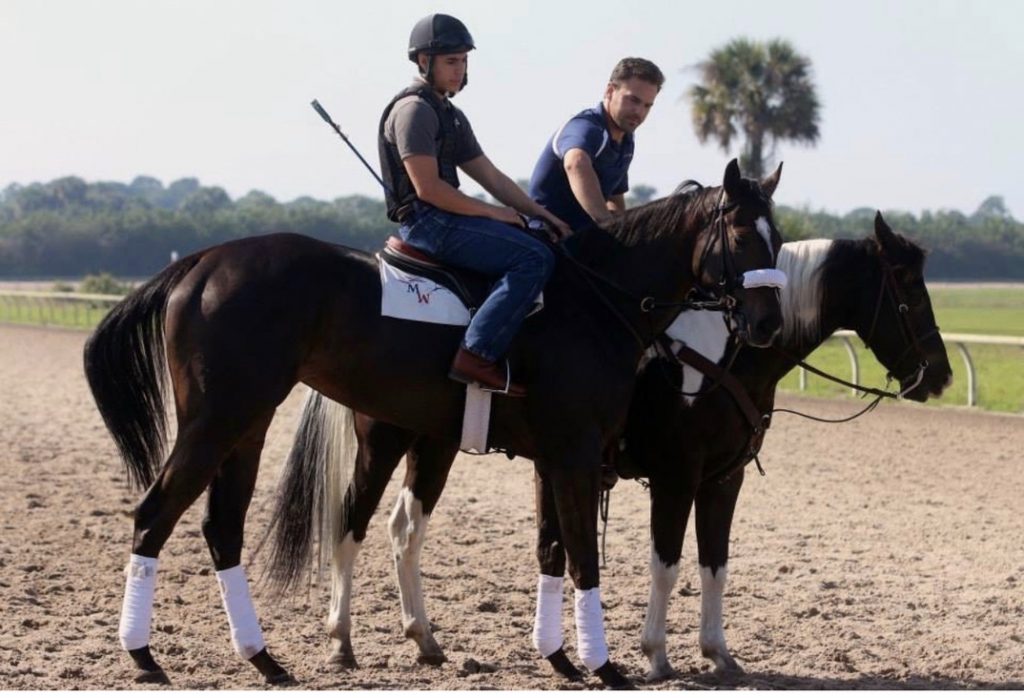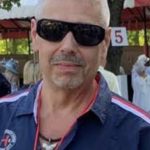
Timing is so important in just about all aspects of life. It can make or break you. Amidst all the issues the sport of thoroughbred racing faces today, one would think it is not the ideal time for a young budding star trainer, who left the game for a while, to make their return. Michael Wilson feels differently, and he is indeed coming back. Actually, he is back with a small, select, but growing string of horses at Santa Anita.
When you look at Michael Wilson, not many people check more of the boxes needed for success in this game. He is a graduate of the Godolphin Flying Start program. That broadened his learning the game to internationally from some of the best in the business. Michael has worked under Melbourne Cup winner Danny O’Brien in Australia. On the world stage, the Melbourne Cup is widely considered one of if not the toughest race to win. In the UK, he worked under Jeremy Noseda. In Dubai he worked under Saed Bin Suroor at Al Quoz.
Back here in the states it was no different. Michael worked under D. Wayne Lukas in Kentucky. In California he worked under Doug O’Neill, Richard Mandella, and Bob Baffert. The Tin Man, Mine That Bird, Indian Blessing, Pioneerofthe Nile, Zensational, Into Mischief, Horse Greely, Dixie Chatter and Crown of Thorns are just some of the Gr.1 stakes horses Michael has worked with. An eager, intelligent son of an equine veterinarian who also happened to be the Director of the Veterinary Hospital at the University of California-Davis, the #1 veterinary school in the world, Michael has all the tools and foundation to make a lot of noise in the Sport of Kings.
Although this is technically a return to the races for Wilson, it can also be thought of as somewhat of his debut. Wilson has started 151 horses but none since 2015. He has had 18 winners, 19 seconds, and 16 thirds for earnings just shy of $1 Million dollars. That was when Michael made his “first debut” in New York training for such high-profile owners as Zayat Stables, Barry Schwartz, Ed Seltzer, & Magalen O. Bryant.
Michael Wilson has a relatively simple philosophy about training and racing. Run sound, happy and healthy horses in the right spots. He believes in as little or even no drugs whatsoever and is all for drug free racing. He supports all the reforms being implemented into the sport and even would prefer stricter. The stricter and more level the playing field, the more he feels his approach will give him a leg up on the competition.
We spoke with Michael Wilson about his return to the game. It was obvious he was itching and anxious to get back to his shed-row. He spoke about how excited he was to employ his attention to detail not just to his horses and employees at the barn, but also to everyone he works with. Vets, blacksmiths, equine masseuse’s, dentists, whoever. They all have to be top shelf and have the same eye for detail.
Michael told me he feels with the uncertainty about the future of racing comes opportunity. He is anxious to set an example of how to do things right and show the sport what that can lead to. We had plenty of questions.
Why did you decide to leave racing back in 2015?
The answer is plain and simple. I support clean racing that looks out for the long-term health & welfare for our equine athletes. Five years ago, I didn’t fully feel our sport mirrored that image. At the same time, I had also developed an interest in business and marketing and wanted to pursue that further while I was still young to see if any of it could be utilized to help racing in the future.
What have you been doing since you left?
My passion for animals is central to my core, so I developed a marketing company in Colorado that helped animal organizations, institutions, and universities communicate more effectively to better connect with the general public. It was great work and I learnt a lot but it was not the same as the love & passion I have for training racehorses.
Have you followed the sport while you were away?
I followed it from afar to keep a pulse on what was going on in the industry. What I found quite interesting was, that you’re either in the business or you’re not. What I mean by that is, there is very much a distance between those of us who work within the industry and those who are fans of the sport. That is something we need to drastically correct. It hinders too many people who have an interest from getting further involved in this great sport.
What do you think is racing’s biggest hurdle today?
I think there are a lot of hurdles for racing but it’s refreshing to watch the initiative our industry has taken and see us tackling them every day. I think we’re getting a better handle on equine health & welfare, transparency, and as Santa Anita’s new tagline says “transforming tradition”. However, the next step is crucial and that’s connecting with the general public and pulling them into the sport to rebuild the sport’s popularity.
If you were appointed commissioner tomorrow, what is the first thing you would change?
I would look into constructing better on-track training facilities for our horses. Training on-track in the United States is rather limiting. We can only go counter-clockwise on the track, unless jogging, and vary the speed or distance with which the horses train. When I worked in other parts of the world; we would swim horses, train them clock-wise one day, counter-clockwise the next, put them on treadmills, roll them in sand pits to loosen up sore muscles and backs, take them on field trips to train in different settings, train uphill, jog downhill, train on undulating surfaces, etc. Yes, the saying is partially true that horses are creatures of habit but they also thrive on variance in routine every now and again. These variances in routine create a much stronger and sounder horse at the end of the day and that’s what we’re all shooting for. There’s a lot of unused real estate at racetracks, specifically infields, that we could use to create new training options for horses. With our product in the sport being horses running in the afternoons, just like any other sport would, we need to ensure our athletes are in peak physical condition and performing to their highest ability. There’s a reason people buy tickets to go watch the Lakers play but wouldn’t pay a dime to watch your average pick-up game. We need to raise the bar on the quality of sport we put out for the general public.
Assuming reforms continue, and racing indeed becomes drug free, do you think it will create more of a horse shortage?
With the way they are gradually instituting these reforms, if we’re talking “horse shortage”, no. In the short term in the entry box, yes. However, the rules are being built to protect horses and by protecting horses they are ensuring horses stay around longer. The days of being able to inject a horse’s ankle and patch them up to make a race are gone. Instead, you now have to give the horse the proper time to heal from an injury which in the long run provides them with a longer racing life, more entries over their career, and a greater earning potential. In terms of bleeder’s, yes. There will be some horses that just won’t be able to run anymore but that’s not a bad thing because in the long run it will strengthen the breed as we won’t want these horses in the gene pool. It will all be worth it in the long run and the industry will be much better for it.
What is your reaction to the recent indictments?
I think it’s great for the sport. It sends a very strong message about the potential consequences of wrongdoing within our sport. Personally, I’ve never felt the penalties for rule violations within American racing have been harsh enough. They’re more like a slap on the wrist and then we give the individual their license back. Harsher penalties will lead to less violations.
Can you go into some more detail on why you feel this is a good time to come back to training?
I know there is a lot of uncertainty in the sport but I strongly feel it is at a turning point that could bring it back to the golden era of racing over the next 10 years. I’ve never seen the speed of movement and reform in the sport that I’ve witnessed over this past year. That gives me a lot of confidence about what we can do as an entire industry. I watched California very closely to see what their response would be to all of the injuries that occurred last year and I couldn’t be happier with how they responded to dramatically improve the sport. Some might think I’m nuts and I get questions all the time “why now?” and “why California?” But I’m so confident about where the sport is positioning itself currently, that I’m betting my future on it.
You have experience with racing all over the world, how does the US stack up against other countries?
That’s a question I’d prefer to take a pass on. Our top race meetings like Santa Anita, Saratoga, Del Mar, Keeneland, Kentucky Downs, and our big race days are pretty special but on an overall scale we have a ways to go to catch countries like Australia and Hong Kong.
What are the major differences between racing on the east coast and the west coast?
Previously, I would have said weather but I’ve been greeted with nothing but rain and only a few days of sunshine since I’ve arrived in Southern California. However, those days of sunshine have been pretty nice. There’s obviously a much larger emphasis on speed and getting horses to the lead or close to it in California vs. on the East Coast where the tracks are more tiring so you can teach a horse to sit and make a late run. However, I used to train on the East Coast like I did when I was an assistant on the West Coast so there wasn’t too much of a difference for me. How you take care of a horse’s feet is pretty different. Santa Anita has a lot of clay in it which dries out a horse’s foot and can make them too hard and prone to quarter cracks. So, using products that help moisturize the hoof wall is critical. On the East Coast, it’s more the opposite issue. There’s so much moisture in the air and on the tracks that a horse’s feet can get a little too soft, so you have to work to keep them dry and use products that help prevent too much moisture from penetrating the hoof wall.
What is the one race you most want to win?
Well there was a cluster of three races between May and June that I really wanted to win but a former mentor of mine beat me to it. Truth be told I made a list 10 years ago of the races that I would most like to win and they are as follows; the Kentucky Derby, the Triple Crown, the Breeders’ Cup Classic, the Prix de l’Arc de Triomphe, the Epsom Derby, the Cox Plate, and the Melbourne Cup.
How are you gonna do it?
I’m going to find a great horse that has Gr. 1 ability on turf and dirt, who likes to travel, and can run off of limited rest. In all honesty, it would be an honor to have a horse that could just win one of these. I’d be extremely grateful.
Time will tell if Michael Wilson will win the Melbourne Cup but given his mind and his tools, if he gets the chance he is probably a bad bet against.



